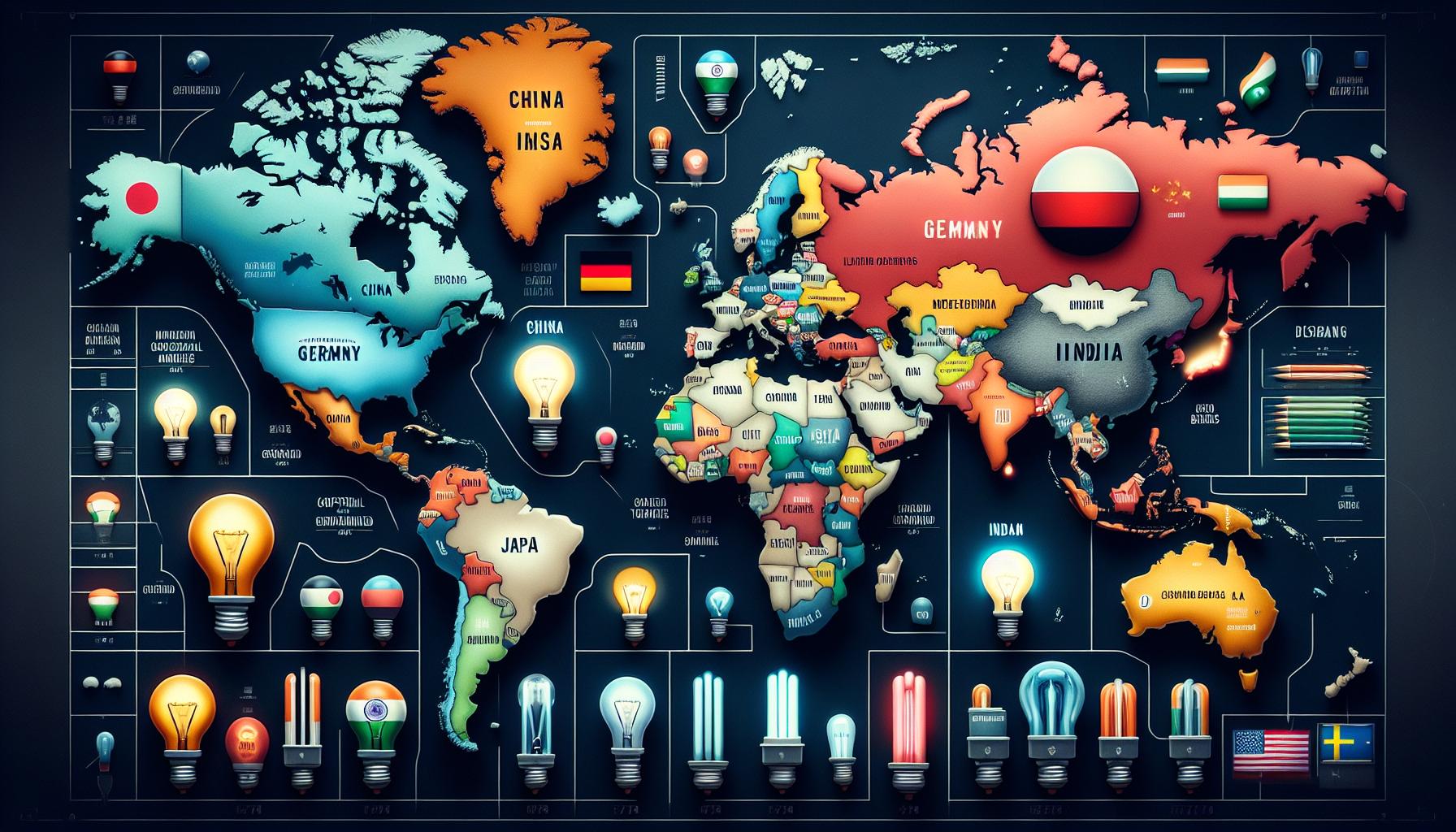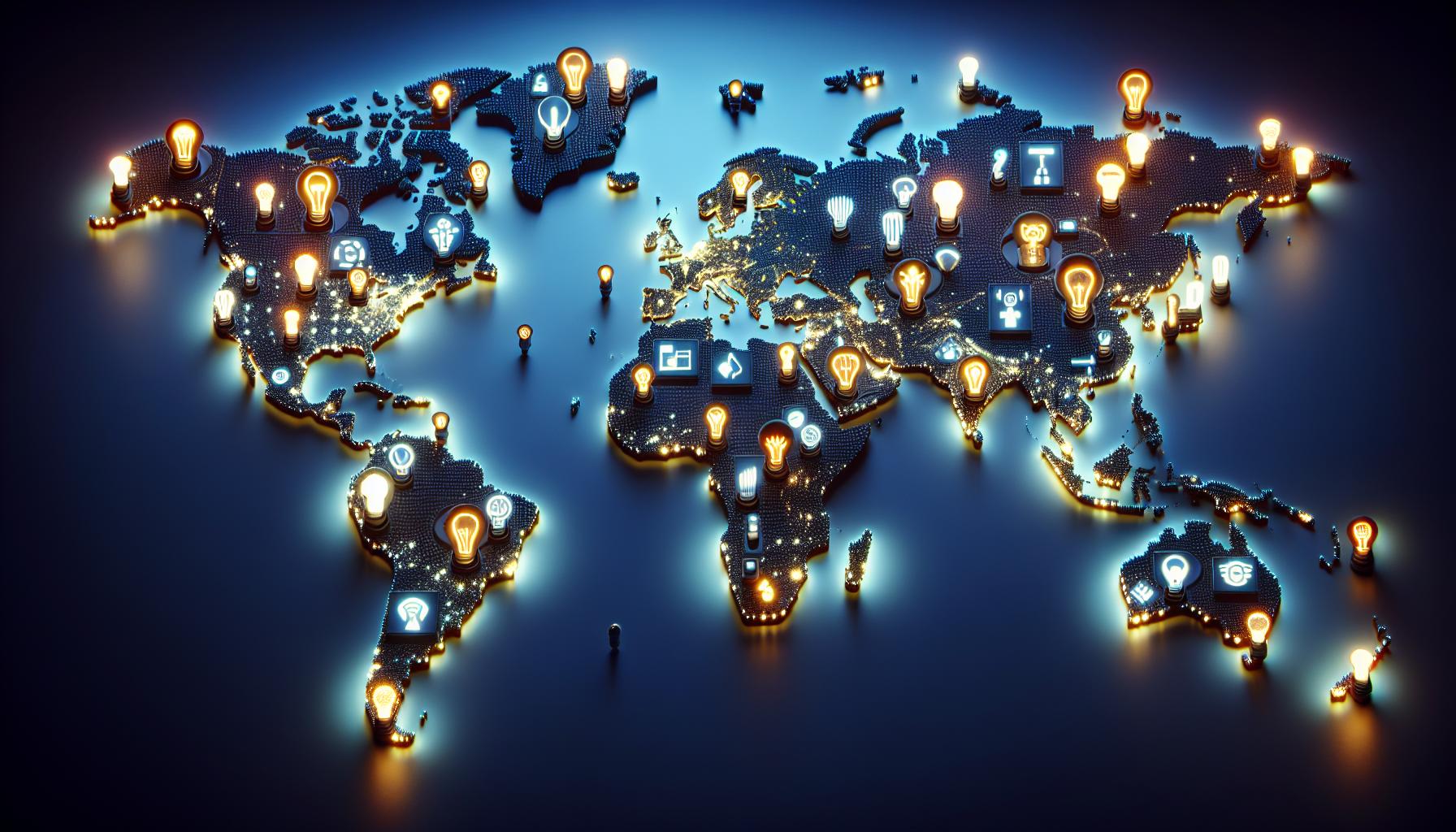Ever wondered where the light bulbs illuminating your home are made? You’re not alone! It’s a bright question that sheds light on the global manufacturing landscape.
From the cozy corners of your living room to the buzzing streets outside, light bulbs are ubiquitous. But their journey to your local store is quite the tale, woven through countries and factories far and wide.
The Importance of Knowing Where Light Bulbs Are Made
As a lighting aficionado, you’re aware that not all light bulbs are created equal. Knowing where your light bulbs are made can offer profound insights into their quality, durability, and environmental impact. This knowledge is not just about satisfying curiosity; it’s also about making informed decisions for your home DIY projects and lighting needs.
When you track the manufacturing origins, you’re peeking behind the curtain, uncovering the materials and practices involved. Various countries have different standards for production, so a light bulb from one region might last longer or shine brighter than its counterpart. This information is crucial when you’re aiming for that perfect ambiance or looking for energy efficiency.
Beyond the practicalities of performance and aesthetics, there’s also the ethical aspect. Production standards vary greatly around the world, and supporting manufacturers who adhere to stringent regulations helps in promoting sustainable and fair labor practices. As you strive to make your home a beacon of comfort and style, it’s worth considering how your choices can light up the world responsibly.
Here are some compelling reasons to know the source of your light bulbs:
- Certified Quality: Bulbs from reputable manufacturers are more likely to meet high-quality standards.
- Warranty: Many companies offer warranties that are country-specific.
- Environmental Impact: Understand the ecological footprint of your lighting choices.
- Economic Considerations: Different import duties and taxes can affect the retail price of light bulbs.
You’re not just purchasing a product, but also the story behind it. The next time you’re knee-deep in your latest home lighting project, take a moment to consider where those light bulbs began their journey. Your choices can cast a much broader glow than what’s solely illuminated in your living room.
Common Countries of Light Bulb Production
When you’re knee-deep in a home DIY lighting project or shopping for new bulbs, you’re not just choosing between LED and incandescent — you’re also buying a piece of international manufacturing. China, for example, is a renowned leader in light bulb production. Factories in China are known for producing a high volume of light bulbs at a rapid pace, which can be beneficial when you’re looking to buy in bulk.
But it’s not just China lighting up the production game. Over in Europe, Germany stands out for its precision engineering and high-quality standards. German light bulbs are often associated with longevity and top-tier performance, making them a reliable choice for your home projects.
On the other side of the world, the United States has a rich history in light bulb innovation, thanks to inventors like Thomas Edison. Contemporary US manufacturers continue this tradition by focusing on advanced technologies and smart lighting solutions.
Here’s a quick look at some of the top players in the light bulb production league:
| Country | Notable Quality |
|---|---|
| China | High Volume |
| Germany | Engineering Precision |
| United States | Advanced Technology |
As you decide where your light bulbs should come from, keep in mind that each country’s manufacturing strengths can contribute to the quality and innovation of the bulbs. For example, Japanese manufacturers are often at the forefront of energy efficiency, whereas countries like India are swiftly climbing the ranks with competitive production capabilities and growing exports.
With sustainability becoming a hot topic, Scandinavian countries are leveraging their eco-friendly reputations to produce bulbs that meet stricter environmental standards. So, when you’re picking out the next set of bulbs, imagining their journey from a production line to your living room might just shine a light on the bigger picture of global manufacturing.
Light Bulb Factories: Who Makes Them?
« Light Bulb Performance by Type: Find Your Ideal Illumination
What Are 100 Watt Light Bulbs: Understanding Brightness and Efficiency »
Delving into the heart of light bulb production, you’ll find a diverse array of factories spread across the globe, each with its distinct advantages. Major players in the industry often have their roots deep in the regions known for innovation and technological prowess. It’s no surprise that brands such as Philips, GE, and Osram are synonymous with lighting solutions; their factories are benchmarks for quality production.
In countries like China, you’ll see the largest volume of light bulb manufacturing due to the availability of low-cost labor and materials. These factories specialize in producing a wide range of bulbs, from the traditional incandescent to the latest in LED technology. What’s fascinating is the scale of operations. Some factories are colossal, capable of churning out millions of light bulbs each month to meet the ever-growing global demand.
Moving west, German light bulb factories are renowned for their precision engineering and rigorous quality control. They often produce specialty and high-end light bulbs, incorporating advanced features that cater to specific needs. If you’re into DIY projects, you know that German-made bulbs are synonymous with reliability and excellence.
Over in the United States, manufacturing focuses on innovation and sustainability. U.S. factories are at the forefront of developing energy-efficient bulbs that not only save you money but also help reduce your carbon footprint. The focus isn’t solely on production but also on how these bulbs can be recycled, embracing a more eco-conscious approach.
Factory tours, often available to the public, can be an eye-opener. You’ll witness firsthand how raw materials transform into the bulbs that light up your home. From the meticulous assembly lines to the final quality checks, every bulb goes through several stages before it’s ready for the shelf.
Remember, each bulb that brightens your living room or workspace carries a story—a confluence of culture, technology, and care from its place of origin. When you twist that bulb into place, you’re not only illuminating your space; you’re sparking a little piece of the world’s manufacturing marvel.
The Journey of a Light Bulb: From Factory to Store
As someone who’s passionate about lighting and DIY projects, you’re aware that the journey of a light bulb is quite remarkable. It starts in the manufacturing facilities you’re familiar with, be it in China, Germany, or the U.S., where each country adds its distinct touch to the making of these illuminating devices.
In China, the light bulb begins as raw materials, which are assembled on large-scale production lines. Economies of scale here mean the bulbs are produced in immense quantities. Following assembly, these bulbs undergo a series of checks to ensure functionality. Standard bulbs might spend less time here, but specialty or high-end bulbs get extra scrutiny.
Moving onto Germany, precision engineering comes into play. The attention to detail is evident as each bulb is meticulously crafted. The engineering prowess ensures that when you install a German-made bulb, you’re not just lighting a room; you’re making a statement about excellence and longevity.
Over in the United States, where you cherish innovation, light bulbs are often pioneering in terms of energy efficiency and smart technology. American-made bulbs may emerge from the production line ready to interact with your smart home systems, offering you convenience and control over your environment.
Before these products hit the shelves, there’s logistics to consider. They’re packaged with care, taking into account the delicate nature of the product. Pallets of bulbs are then shipped globally, winding their way through a network of distributors and retailers. Tracking systems ensure that every bulb can be accounted for, providing data on shipping times and inventory levels.
Once they arrive at the store, they’re strategically displayed. Retailers know that lighting plays a crucial role in how products are perceived, so they use the very bulbs they sell to cast the right ambiance, enticing you to envision how they might look in your own home. Whether you’re browsing online or in-person, the light bulb’s journey ends when you make your selection, and it brightens your home with just a flip of a switch.
The Impact of Global Manufacturing on Light Bulbs
The global landscape of light bulb production has profound implications on both the economy and the environment. Production localization plays a critical role in defining the cost and carbon footprint of the light bulbs you use at home or work.
Economies of Scale come into play significantly in countries like China. These production giants can lower the per-unit cost of light bulbs due to their massive output. The savings often trickle down to you, but they’re not the only factor to consider. Bulk manufacturing can also lead to increased carbon emissions—something to keep in mind if you’re environmentally conscious.
In regions like Europe, where stringent regulations govern manufacturing, there is a notable difference in the approach. Manufacturers may produce fewer bulbs, but these generally boast higher energy efficiency and lower environmental impact. They also have a longer lifespan, saving you money on replacements in the long-run.
Let’s not forget the innovation hotbeds like the United States, where manufacturing focuses on advancing technology. Here, the bulbs might cost more upfront, but the integration of smart technology allows for energy usage to be finely tuned to your needs, helping you save on your energy bill.
When you think about the journey of a light bulb, it’s not just the miles it travels from the factory to your local store. It’s also the research and development; the labor and material costs; and the environmental regulations that differ from country to country. These factors collectively shape the product’s final cost, its efficiency, and its impact on the planet.
- Light bulb manufacturing varies greatly around the world.
- Choices in production can affect both price and carbon footprint.
- Innovative technology in the lighting industry is driven by local market demands and regulations.
Considering the environment and your wallet, it’s crucial to balance the upfront cost of a bulb with its operational efficiency and lifespan. The origins of a light bulb matter more than you might think – affecting everything from your energy consumption to global trade flows.
Conclusion
So you’ve seen the global journey of light bulbs, from factories to your local store shelves. Whether it’s the mass-produced models from China, precision-crafted ones from Germany, or the cutting-edge smart bulbs from the US, each has its own story. Remember, when you’re picking out your next bulb, you’re not just buying a product. You’re choosing from a world of innovation, craftsmanship, and strategic design. It’s all about finding the perfect balance between cost, efficiency, and environmental impact for your needs. Happy lighting!
Frequently Asked Questions
What countries are mentioned in the article regarding light bulb manufacturing?
The article discusses light bulb manufacturing in China, Germany, and the United States, each with its own focus: China prioritizes quantity and function checks, Germany emphasizes precision and longevity, while the US focuses on innovation and energy efficiency.
How does the manufacturing process differ among the countries mentioned?
In China, light bulbs are produced in large quantities with functional checks. Germany emphasizes precision engineering for excellence and longevity. The United States prioritizes innovation, incorporating smart technology for energy efficiency.
What is the focus of light bulb manufacturing in the United States?
The focus in the United States is on innovation and energy efficiency. U.S. manufacturers often integrate smart technology into their light bulbs, aiming to advance operational efficiency and the product’s lifespan.
What logistics are involved in getting the bulbs to the store?
The logistics include packaging the bulbs safely and shipping them globally. A strategic display in stores also plays an essential role in creating an inviting ambiance for customers.
What new points does the article discuss about global light bulb manufacturing?
The article touches on the economies of scale in China, environmental considerations, and the European focus on higher energy efficiency and reduced environmental impact. It also discusses the importance of upfront costs, operational efficiency, and lifespan considerations in the United States.
How do environmental considerations factor into light bulb manufacturing?
European manufacturers focus on producing light bulbs with higher energy efficiency and a lower environmental impact. The global industry is also increasingly considering environmental factors in the manufacturing process.





